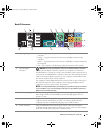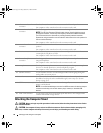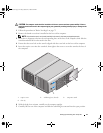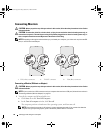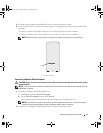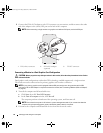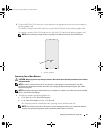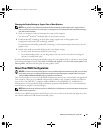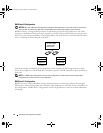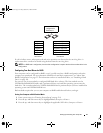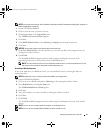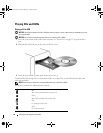
Setting Up and Using Your Computer 25
Changing the Display Settings to Support Two or More Monitors
NOTE: Dual graphics card configurations with multi-GPU technology enabled support only a single monitor. In
order to connect and use two or more monitors in a dual graphics card configuration with multi-GPU technology,
multi-GPU must be disabled.
1
With your monitors connected and turned on, turn on the computer.
The Microsoft
®
Windows
®
desktop displays on the primary monitor.
2
Disable multi-GPU technology in the display settings (applies only to dual graphics card
configurations with multi-GPU technology enabled):
For information on disabling multi-GPU technology, see the documentation that came with your
graphics card.
3
Enable clone mode or extended desktop mode in the display settings.
• In clone mode, all monitors display the same image.
• In extended desktop mode, you can drag objects from one screen to the other, increasing the
amount of viewable work space.
For more information on changing the display settings for your graphics card, see the device user’s guide
in the Help and Support Center (click Start, click Help and Support, click User and system guides, click
Device guides, and then click the guide for your graphics card).
About Your RAID Configuration
NOTICE: In order to use the migrating option to convert a RAID configuration without losing data, your hard drive
must initially be set up as a single drive RAID 0 array before the operating system is loaded onto the drive (see
"Using the NVIDIA MediaShield ROM Utility" on page 28 for instructions).
This section provides an overview of the RAID configuration you may have selected when you purchased
your computer. There are several RAID configurations available in the computer industry for different
types of uses. Your Dell XPS™ computer supports RAID level 0 and RAID level 1. A RAID level 0
configuration is recommended for high-performance programs while RAID level 1 is recommended for
users that desire a high level of data integrity.
NOTE:
RAID levels do not represent a hierarchy. A RAID level 1 configuration is not inherently better or worse than
a RAID level 0 configuration.
The drives in a RAID configuration should be the same size in order to ensure that the larger drive does
not contain unallocated (and therefore unusable) space.
book.book Page 25 Friday, October 27, 2006 4:02 PM



